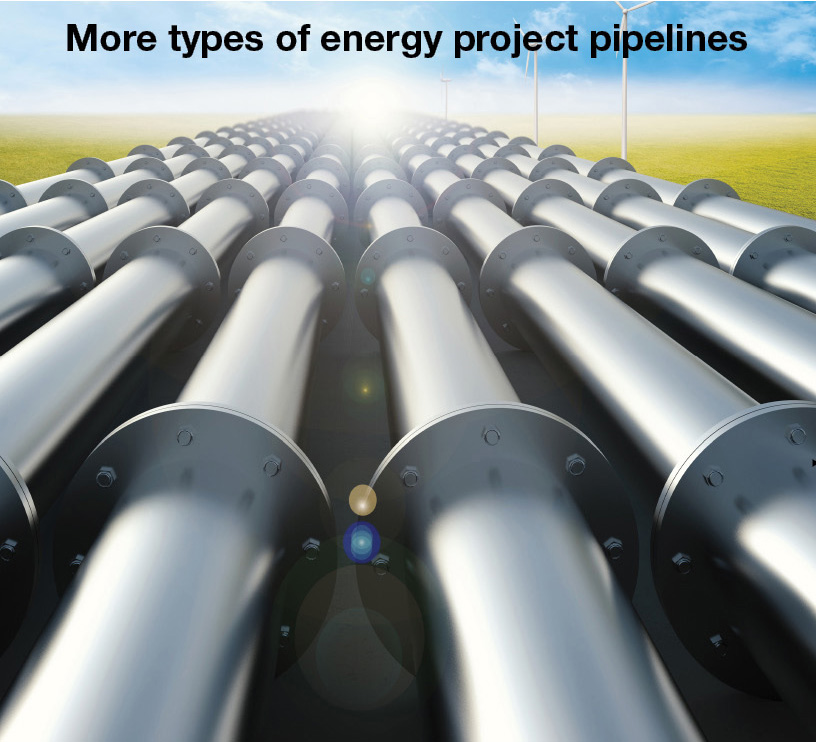Editorial:
 Despite the visible challenges for a few high profile pipelines, the true story on the ground for most of the energy sector is an impressive expansion in the diversity and speed of energy pipelines.. Many of these go largely unnoticed because they are upstream wholesale investments specific to certain subsectors. But make no mistake: new project pipelines of several types are coming.
Despite the visible challenges for a few high profile pipelines, the true story on the ground for most of the energy sector is an impressive expansion in the diversity and speed of energy pipelines.. Many of these go largely unnoticed because they are upstream wholesale investments specific to certain subsectors. But make no mistake: new project pipelines of several types are coming.
Jurisdictions with competitive wholesale markets are seeing dollars flowing at unprecedented rates into new types of energy capacity, creating project pipelines like none before. Consider some of the recent examples:
• Construction of Canada's Trans Mountain pipeline is moving ahead rapidly with an expected in-service date of December 2022.
• On May 12 authorities in Maine approved the New England Clean Energy Connect (NECEC) project, a 145-mile transmission line that will deliver 1,200 MW of hydropower from Quebec.
• 8minute Solar announced on June 1 that it had secured funding for the next phase of its 18-gigawatt (GW) pipeline of solar and storage projects throughout the Southwestern United States.
• On July 22, New York State Governor Andrew Cuomo announced what he called the largest combined clean energy solicitations ever issued in the U.S.
• Analysts report over 9 GW of large-scale subsidy-free solar built or underway in the UK.
• Broad Reach Power announced June 9 that it will build 15 utility-scale battery storage plant sites in Texas, creating a project pipeline the likes of which has never been seen before in energy storage.
• Pacific Gas and Electric Company announced June 11 that its regulator had approved comprehensive proposals to encourage the development of several categories of new microgrids in California that will assist customers to cope more effectively with outages and power quality problems.
• The technology for small modular reactors is progressing at an impressive pace, raising the possibility of a new class of supply entering world markets.
• Public Energy believes that the industry can finance and build large numbers of gas-fired power projects in Ontario based on the spread between prevailing gas and electricity costs.
• TC Energy, famous for building conventional pipelines, recently invested in the Canyon Creek Project, a pumped hydro energy storage facility to be located near Hinton, Alberta, and you guessed it – is working on a pipeline of other projects including a 1 GW pumped storage project in Ontario.
Undeterred by the pandemic, each of these new pipelines has the potential to bring more dependable supply onto the market at historically low prices, controlled in large part by competitive forces that should exert discipline on prices for years to come. Details on most of them can be found elsewhere in this issue of IPPSO FACTO. We considered labelling this “the pipeline issue.”
These energy project pipelines are unprecedented because of their scale individually, because of their diversity, and because so many appear to be entering the market at the same time. While many commercial factors have yet to play out, the most likely outcome of so much development is a period of ample supply, a buyer’s market with relatively low per-unit energy costs. The primary challenges for regulators and policy makers under such conditions will not be how to find enough energy at reasonable prices, but how to reasonably assign cost responsibility for all the infrastructure built to distribute and manage the low cost supply.
The pipeline business suddenly has a lot more players on the field. While it’s anybody’s guess what the picture will look like when all the pipeline plans have been reshaped by competition and other forces, it’s apparent that the business of energy pipelines now includes more than supply lines from oil and gas fields.
What makes all of this possible is access to a critical resource that’s available in every country in the world: The pipeline of new ideas. This is the real reason the energy sector holds so much promise.
— Jake Brooks
